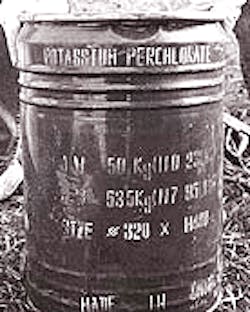EPA has established its first safety standard for perchlorate, a toxic chemical used in rocket fuel and explosives which has been blamed for widespread drinking water contamination, especially near military sites.
EPA has established an official reference dose (RfD) of 0.0007 mg/kg/day of perchlorate. This level is consistent with the recommended reference dose included in the National Academy of Science's January 2005 report.
A reference dose is a scientific estimate of a daily exposure level that is not expected to cause adverse health effects in humans.
Perchlorate has been used in various items, including missile and rocket propellants, munitions and fireworks, flares, automobile airbags and pharmaceuticals. It may also occur naturally and has been found in some fertilizer. Perchlorate has been detected in drinking water in some systems around the country, as well as in some foods.
EPA's reference dose, which assumes total intake from both water and food sources, is deemed to be appropriate and protective for all populations, including the most sensitive subgroups. The selected reference dose contains a full ten-fold "uncertainty factor" to protect the most sensitive population, the fetuses of pregnant women who might have hypothyroidism or iodide deficiency.
This uncertainty factor also covers variability among other human life stages, gender and individual sensitivities, protecting not only adults, but also other sensitive subpopulations such as premature neonates, infants and developing children.
Perchlorate exposure has the potential of blocking iodide uptake to the thyroid gland. NAS identified the non-adverse effect of the inhibition of iodine uptake as the key biochemical event that precedes the occurrence of all potential adverse effects of perchlorate exposure.
EPA officials believe the RfD is conservative and health protective because it is designed to prevent the occurrence of any biochemical changes that could lead to adverse health effects.
The reference dose for perchlorate will be posted on EPA’s online IRIS database, which contains risk information on possible human health effects from exposure to chemical substances in the environment.
EPA's new RfD translates to a Drinking Water Equivalent Level (DWEL) of 24.5 ppb. A Drinking Water Equivalent Level, which assumes that all of a contaminant comes from drinking water, is the concentration of a contaminant in drinking water that will have no adverse effect with a margin of safety. Because there is a margin of safety built into the RfD and the DWEL, exposures above the DWEL are not necessarily considered unsafe.
EPA's Superfund cleanup program plans to issue guidance based on the new RfD.
Perchlorate has been used in various items, including missile and rocket propellants, munitions and fireworks, flares, automobile airbags and pharmaceuticals. It may also occur naturally and has been found in some fertilizer. Perchlorate has been detected in drinking water in some systems around the country, as well as in some foods.
The perchlorate summary is available on the IRIS web site at http://www.epa.gov/iris and at http://www.epa.gov/perchlorate.
Source: EPA
